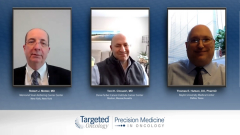
Promising Studies for the Future of Frontline mRCC
Toni Choueiri, MD, closes with promising new studies that will impact metastatic clear-cell renal cell carcinoma therapeutics in the years to come.
Episodes in this series

Robert J. Motzer, MD: Toni, you’re the leader of the COSMIC-313 study and also the belzutifan studies. Do you want to speak to those trials in terms of where they stand and what people should be watching for and anticipating with those studies?
Toni K. Choueiri, MD: Thank you, Bob. COSMIC-313 is a study that asked the question, “Is 3 superior to 2?” We went through this lovely talk from 1 to 2, to perhaps a 3, where cabozantinib is going to be added to nivolumab and ipilimumab vs controlled nivolumab and ipilimumab and modern control finally, not sunitinib. The study just finished. Accrual about to wrap up was primary end point PFS [progression-free survival], secondary end point OS [overall survival] with over 800 patients. In intermediate and poor risk, it’s important to see if we can push survival more and push the CRs [complete responses] more.
The second study you alluded to is a study with a totally new agent. Here, we’re not adding drugs that are already approved as single agent or combo. Belzutifan is an HIF2 inhibitor, and Tom in a very eloquent way discussed the biology of clear-cell RCC [renal cell carcinoma] initially. HIF2 is a transcription factor thought for a long time to be completely undruggable. HIF2 doesn’t have those small pockets where the drugs could go until recently, with elegant crystallographic work showing it could. We could have molecules and the second-generation molecule MK 6482 belzutifan showing a response rate and a refractory population of clear cell RCC of more than 50 patients. It’s mostly at 25% with quite tolerable adverse effects. You don’t have diarrhea, hypertension, and anemia, which is on target because you target downstream HIF2.
Down regulating actually could be a pharmacodynamic biomarker with these drugs. Hypoxia was another, which is likely on target. Toxicity was HIF2 physiology. We’re taking this to a phase 3 trial post-VEGF inhibitor plus PD-1 inhibitor, belzutifan against everolimus later lines. And belzutifan is being introduced first line and second line with other studies that are being planned. The 1 thing about this treatment, as Tom mentioned, is that the time to respond seems to be not 2 to 3 months with single-agent TKI or less than 2 months with the combos, but it takes time—around 6, 6½ months with it. It doesn’t work quickly if you want an average. But it’s a nice set addition, and I hope this would be there. Data also in VHL [von Hippel–Lindau] syndrome associated clear-cell RCC, where we saw some image of blastoma is shrinking. Just yesterday or the day before, there was an FDA note about. VHL syndrome is scheduled, I believe in September. This is all good news for the renal cell cancer field.
This transcript has been edited for clarity.








































